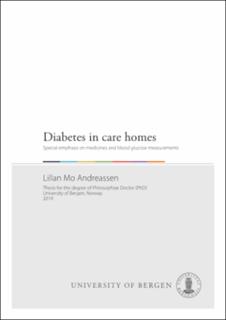| dc.contributor.author | Andreassen, Lillan Mo | en_US |
| dc.date.accessioned | 2019-11-04T13:20:44Z | |
| dc.date.available | 2019-11-04T13:20:44Z | |
| dc.date.issued | 2019-09-20 | |
| dc.date.submitted | 2019-09-04T13:02:35.160Z | |
| dc.identifier | container/2c/2b/71/8b/2c2b718b-793f-4f2b-99d3-da53afc245aa | |
| dc.identifier.isbn | 9788230849279 | en_US |
| dc.identifier.isbn | 9788230858547 | en_US |
| dc.identifier.uri | https://hdl.handle.net/1956/20950 | |
| dc.description.abstract | Diabetes mellitus (DM) is prevalent among older adults and leads to disability, frailty, and dependency. In care homes, multimorbidity and polypharmacy may further complicate the management of DM and increase the risk of adverse events. This thesis aims to investigate the prevalence and management of DM in care homes, with special emphasis on medicines and blood glucose measurements. Paper I was a cross-sectional study of 742 residents from 19 Norwegian nursing homes (NHs). We found a DM prevalence of 16 % (n=116), and that 74 % of residents with DM used blood glucose-lowering medicines. CBGM the last four weeks was registered for 73 % of the residents, frequency varied from daily to monthly. Six out of ten residents had at least one blood glucose reading <6.0 mmol/L. An HbA1c value the last twelve months was recorded for 77 % of residents, with a mean of 57 mmol/mol (7.3 %) and a range of 28-112 mmol/mol (4.7-12.4 %). Paper II was a retrospective study of 826 residents from 30 English care homes, using baseline data from the CAREMED study. For residents with type 2 DM (T2DM), we described comorbidities and prescriptions, and identified potentially inappropriate medicines (PIMs). Of the 106 residents with T2DM, 76 % used blood glucoselowering medicines. The number of comorbidities, prescriptions, and residents using ≥5 medicines was higher among residents with T2DM compared to residents without DM. We identified 346 PIMs, and nine out of ten residents with T2DM had at least one PIM. Of the 67 PIMs in the 20 % resident sample for validation, a care home physician agreed that 26 and 40 of them could be directly discontinued or considered discontinued, respectively. Paper III was a qualitative study exploring the perspectives of NH staff on the use and usefulness, procedures, and potential challenges of CBGM in Norwegian NHs. We conducted three profession-specific focus groups, including five physicians, four registered nurses, and three auxiliary nurses, using a semi-structured interview guide. All professional groups found CBGM necessary when caring for residents with DM,but tried to minimise its use to ease the strain on the residents. The participants mentioned access to and familiarity with procedures, equivalent practice, explicit documentation routines, and sufficient training in DM and its symptoms as means by which to promote the appropriate use of CBGM and ensure patient safety. Currently, one or several of these factors were lacking. In conclusion, the research in this thesis shows that care home residents with DM suffer a high burden of medicines in general and use of DM medicines in particular. Patient safety may be further compromised by the lack of training and procedures in regard to CBGM and recognising deviant blood glucose concentrations. Thus, the potential to optimise medicine use and improve blood glucose-monitoring practices should be investigated further. | en_US |
| dc.language.iso | eng | eng |
| dc.publisher | The University of Bergen | eng |
| dc.relation.haspart | Paper I Andreassen LM, Sandberg S, Kristensen GBB, Solvik UO, Kjome RLS. Nursing home patients with diabetes: Prevalence, drug treatment and glycemic control. Diabetes Res Clin Pract 2014; 105(1):102-9. The article is available in the main thesis. The article is also available at: <a href=" http://hdl.handle.net/1956/8880" target="blank"> http://hdl.handle.net/1956/8880</a>. | en_US |
| dc.relation.haspart | Paper II Andreassen LM, Kjome RLS, Solvik UO, Houghton J, Desborough JA. The potential for deprescribing in care home residents with Type 2 diabetes. Int J Clin Pharm 2016; 38(4): 977-84. The article is available in the main thesis. The article is also available at: <a href=" http://hdl.handle.net/1956/15327" target="blank"> http://hdl.handle.net/1956/15327</a>. | en_US |
| dc.relation.haspart | Paper III Andreassen LM, Granas AG, Solvik UO, Kjome RLS. ‘I try not to bother the residents too much’ – the use of capillary blood glucose measurements in nursing homes. BMC Nurs 2016; 15: 7. The article is available in the main thesis. The article is also available at: <a href=" http://hdl.handle.net/1956/12192" target="blank"> http://hdl.handle.net/1956/12192</a>. | en_US |
| dc.rights | In copyright | eng |
| dc.rights.uri | http://rightsstatements.org/page/InC/1.0/ | eng |
| dc.title | Diabetes in care homes : Special emphasis on medicines and blood glucose measurements | en_US |
| dc.type | Doctoral thesis | |
| dc.date.updated | 2019-09-04T13:02:35.160Z | |
| dc.rights.holder | Copyright the Author. All rights reserved | |
| dc.identifier.cristin | 1724057 | |
| fs.unitcode | 13-26-0 | |
